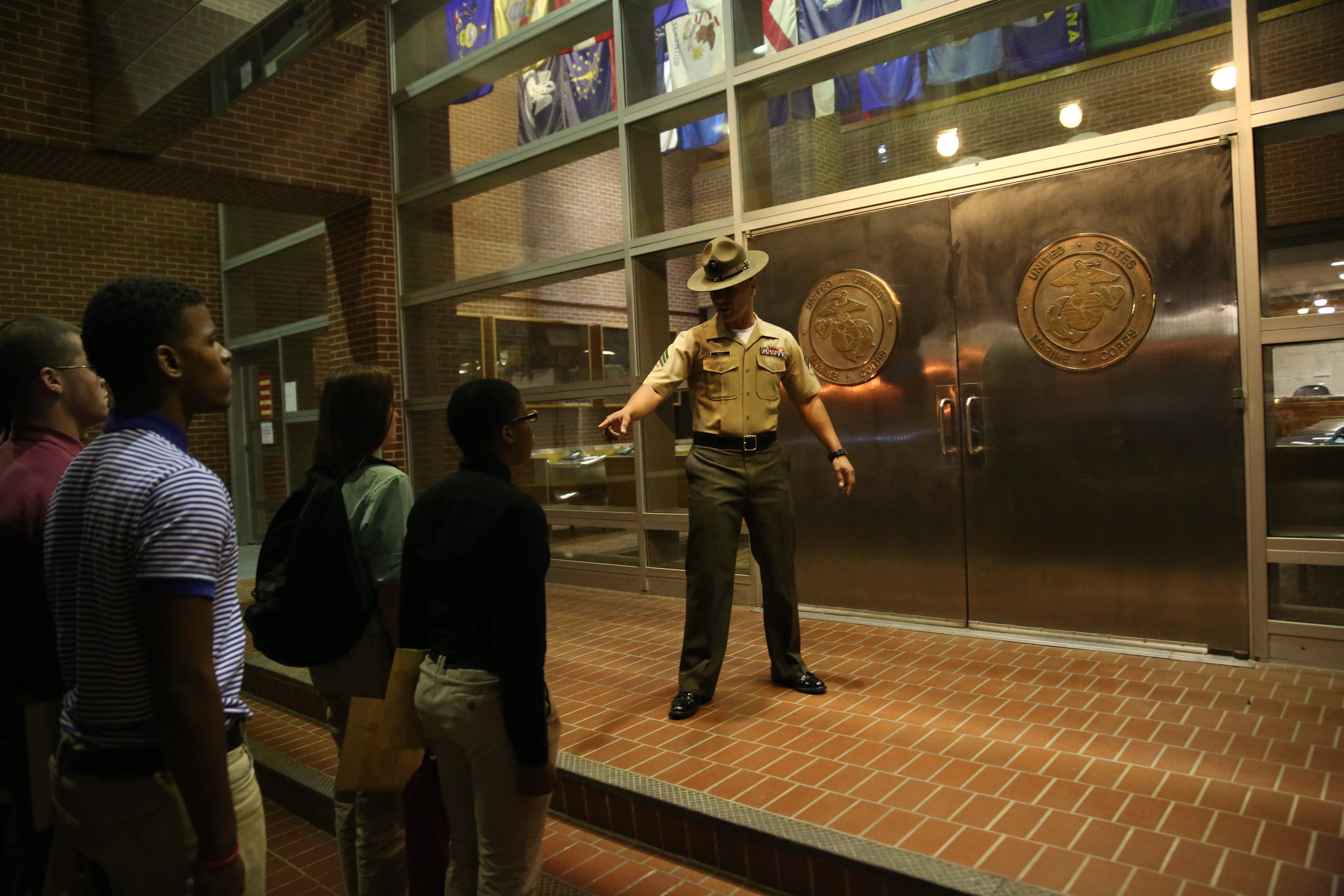The Marine Corps' fiscal 2017 budget request shows that it's getting harder to keep the service ready to fight anywhere, anytime under budget cuts imposed by Congress.
A recent two-year budget agreement hashed out by lawmakers left the Defense Department with $17 billion less in fiscal 2017 than it expected to receive. As a result, the Department of the Navy's budget is projected to take a $7 billion hit next fiscal year.
Faced with numerous global threats, the Marine Corps is spending more money on readiness at the expense of military construction and other budget items.
Here is what you need to know about the Marine Corps' proposed fiscal 2017 budget:

Sgt. Tyler Felts, an LAV crewman, sights in on a target during a live-fire gunnery qualification test with an M240B machine gun at Marine Corps Air Ground Combat Center Twentynine Palms on Jan. 22.
Photo Credit: Pvt. Robert Bliss/Marine Corps
1. Readiness. The drawdown is expected to end by October, so the fiscal 2017 budget request would keep the Marine Corps' active-duty end strength at 182,000. The service also plans to spend a total of $1.4 billion on readiness next fiscal year, compared with $1.3 billion in fiscal 2016.
While the proposed operation and maintenance spending would fund a "ready and capable Marine Corps across the range of military operations," it is still leaner that it has been in the past, Rear Adm. William Lescher told reporters at a Tuesday news conference.
As a result, the Marine Corps will be stretched to maintain readiness while preserving modernization programs meant to keep pace with evolving threats, said Lescher, the flag officer in charge of the Navy's budget department.
"The budget prioritizes a readiness of deployed and next-to-deploy units to meet today's operational requirements," he said. "Nondeployed units will not have the resources and time to maintain the readiness required to deploy immediately."

Maj. Jason P. Quinter reunites with his children after returning home from a deployment in support of Operation Enduring Freedom, aboard Camp Pendleton, Calif., on Nov. 6, 2014.
Photo Credit: Staff Sgt. Justin Kronenberg/Marine Corps
2. Dwell time. Even though the Marine Corps has shrunk by roughly 20,000 Marines since reaching its peak size in fiscal 2009, the service remains committed to providing active-duty personnel with two months at home for every month deployed, Lescher said Tuesday.
Ultimately, the Marine Corps hopes to give the active-duty force three months at home for every month deployed and Reserve Marines and sailors four months back for every month they are deployed, he said.
"At this force level, the commandant has testified that Marine Corps major combat operations in one theater would entail risk in 'deter and deny' operations elsewhere, with the force structure insufficient to support the other commitments, including theater security cooperation," Lescher said.

In this photo posted on the website of the office of the Iranian supreme leader Jan. 24, Iranian leader Ayatollah Ali Khamenei greets Revolutionary Guard officers involved in the detention of U.S. Navy sailors in Iranian waters earlier in January, during their meeting in Tehran.
Photo Credit: Office of the Iranian Supreme Leader via AP
3. Bad guys. There is no shortage of potential adversaries across the world.
"For the first time in 25 years, the United States is facing a return to great power competition with both Russia and China advancing high-end military capabilities," Lescher said.
Meanwhile, North Korea continues to be focused on its nuclear weapons and missile programs; and Iran is pursuing advanced missiles and enhancing its conventional weapons, he said.
Lescher also mentioned "non-state actors exploiting the maritime and information systems to threaten security around the world," but he did not name a specific group. A slide on global threats from Tuesday's briefing includes the Islamic State's flag.
"As Commandant [Gen. Robert] Neller has stated: 'The character of warfare is dynamic. Those who adapt succeed. Those who don't die,'" Lescher said.

Senior drill instructor Sgt. Fernando Horta speaks to soon-to-be recruits moments before they enter the recruit receiving building on Parris Island, S.C., in a photo from 2014.
Photo Credit: Cpl. Octavia Davis/Marine Corps
4. Military construction. The Marine Corps' budget request would provide a total of $426 million in fiscal 2017, a 43.5 percent reduction from the $754 million budgeted for this fiscal year, according to the Marine Corps.
"The [Navy] Department continues to pressurize military construction in order to meet fiscal constraints limiting projects to the department's most critical needs," Lescher said.
The proposed budget would fund 11 construction projects, including a new barracks and reconditioning center at Marine Corps Recruit Depot Parris Island, South Carolina, Marine Corps officials said.
While new electrical transmissions are set to be built next fiscal year in Guam as part of efforts to relocate Marines there from Okinawa, three other construction projects that had been slated for Guam in fiscal 2017 have been delayed by budget constraints, Lescher said.

Marine Corps Sgt. Luke Gehrke re-enlists at Marine Corps Base Camp Lejeune, N.C., on Feb. 11, 2015.
Photo Credit: Lance Cpl. Caleb McDonald/Marine Corps
5. Bonuses and special pays. The Marine Corps has budgeted $120.3 million for bonuses and special pays in fiscal 2017, said Doug Matties, with the service's office of Programs and Resources.
That money would go toward the Marine Corps' re-enlistment bonus, enlistment bonus, critical skills retention bonus and assignment incentive pay programs, Matties said in an email Tuesday to Marine Corps Times.
A Marine Corps retention survey in fiscal 2015 found that more re-enlistment-eligible Marines than in past years plan to leave the service. Neller has told commanders to talk to their Marines and encourage their top performers to stay.
"We are going to put a little bit more pressure on commanders to be involved with the retention process," Neller told Marine Corps Times in a Jan. 20 interview. "I mean, we are all recruiters. We are all career planners."
The proposed budget would also fund sea and foreign duty pay; diving duty pay; imminent danger pay; foreign language proficiency pay; special duty assignment pay; and personal money allowance — general and flag law school education debt subsidy, Matties said.




